Related Research Articles

An exoplanet or extrasolar planet is a planet outside the Solar System. The first possible evidence of an exoplanet was noted in 1917 but was not then recognized as such. The first confirmed detection of an exoplanet was in 1992 around a pulsar, and the first detection around a main-sequence star was in 1995. A different planet, first detected in 1988, was confirmed in 2003. As of 24 January 2025, there are 5,830 confirmed exoplanets in 4,354 planetary systems, with 976 systems having more than one planet. In collaboration with ground-based and other space-based observatories the James Webb Space Telescope (JWST) is expected to give more insight into exoplanet traits, such as their composition, environmental conditions, and potential for life.
HD 6434 is a star in the southern constellation of Phoenix. Yellow dwarfs such as this are not very luminous, so at a distance of 138 light years it is not visible to the unaided eye. However, with binoculars it is readily visible under ideal observing conditions, having an apparent visual magnitude of 7.71. The star is drifting further from the Sun with a radial velocity of +23 km/s.

An exomoon or extrasolar moon is a natural satellite that orbits an exoplanet or other non-stellar extrasolar body.

A shepherd moon is a small natural satellite that clears a gap in planetary ring material or keeps particles within a ring contained. The name is a result of their limiting the "herd" of the ring particles as a shepherd.

HAT-P-1b is an extrasolar planet orbiting the Sun-like star HAT-P-1, also known as ADS 16402 B. HAT-P-1 is the dimmer component of the ADS 16402 binary star system. It is located roughly 521 light years away from Earth in the constellation Lacerta. HAT-P-1b is among the least dense of any of the known extrasolar planets.

HD 189733 b is an exoplanet in the constellation of Vulpecula approximately 64.5 light-years away from the Solar System. Astronomers in France discovered the planet orbiting the star HD 189733 on October 5, 2005, by observing its transit across the star's face. With a mass 11.2% higher than that of Jupiter and a radius 11.4% greater, HD 189733 b orbits its host star once every 2.2 days at an orbital speed of 152.0 kilometers per second, making it a hot Jupiter with poor prospects for extraterrestrial life.

The habitability of natural satellites is the potential of moons to provide habitats for life, though it is not an indicator that they harbor it. Natural satellites are expected to outnumber planets by a large margin and the study of their habitability is therefore important to astrobiology and the search for extraterrestrial life. There are, nevertheless, significant environmental variables specific to moons.

WASP-12b is a hot Jupiter orbiting the star WASP-12, discovered in April of 2008, by the SuperWASP planetary transit survey. The planet takes only a little over one Earth day to orbit its star, in contrast to about 365.25 days for the Earth to orbit the Sun. Its distance from the star is only the Earth's distance from the Sun, with an eccentricity the same as Jupiter's. Consequently, it has one of the lowest densities for exoplanets. On December 3, 2013, scientists working with the Hubble Space Telescope (HST) reported detecting water in the atmosphere of the exoplanet. In July 2014, NASA announced finding very dry atmospheres on three exoplanets orbiting sun-like stars.
HD 65216 b is an extrasolar planet located approximately 115 light-years away in the constellation of Carina, orbiting the star HD 65216. This planet was discovered by the Geneva Extrasolar Planet Search Team in 2003. Like most planet candidates so far, it was detected with the radial velocity method.

Kepler-16b is a Saturn-mass exoplanet consisting of half gas and half rock and ice. It orbits a binary star, Kepler-16, with a period of 229 days. "[It] is the first confirmed, unambiguous example of a circumbinary planet – a planet orbiting not one, but two stars," said Josh Carter of the Center for Astrophysics | Harvard & Smithsonian, one of the discovery team.

An exocomet, or extrasolar comet, is a comet outside the Solar System, which includes rogue comets and comets that orbit stars other than the Sun. The first exocomets were detected in 1987 around Beta Pictoris, a very young A-type main-sequence star. There are now a total of 27 stars around which exocomets have been observed or suspected.

J1407b is a substellar object, either a free-floating planet or brown dwarf, with a massive circumplanetary disk or ring system. It was first detected by automated telescopes in 2007 when its disk eclipsed the star V1400 Centauri, causing a series of dimming events for 56 days. The eclipse by J1407b was not discovered until 2010, by Mark Pecaut and Eric Mamajek, and was announced in 2012. J1407b's disk spans a radius of about 90 million kilometers and consists of many rings and gaps which may indicate moons are forming in orbit around the object. It was initially thought to be orbiting V1400 Centauri, but later studies suggest J1407b is likely an unbound object that coincidentally passed in front of the star. J1407b may have been observed via high-resolution imaging in 2017, which may suggest the object is less than 6 Jupiter masses.

The Next-Generation Transit Survey (NGTS) is a ground-based robotic search for exoplanets. The facility is located at Paranal Observatory in the Atacama Desert in northern Chile, about 2 km from ESO's Very Large Telescope and 0.5 km from the VISTA Survey Telescope. Science operations began in early 2015. The astronomical survey is managed by a consortium of seven European universities and other academic institutions from Chile, Germany, Switzerland, and the United Kingdom. Prototypes of the array were tested in 2009 and 2010 on La Palma, and from 2012 to 2014 at Geneva Observatory.

Tabetha "Tabby" Suzanne Boyajian is an American astronomer and associate professor at Louisiana State University. She works in the fields of stellar interferometry, stellar spectroscopy, exoplanet research, and high angular resolution astronomy, all particularly at optical and infrared wavelengths. Boyajian was the lead author of the September 2015 paper "Where's the Flux?", which investigated the highly unusual light curve of KIC 8462852; the star is colloquially known as Tabby's Star in her honor.

In astronomy, a disrupted planet is a planet or exoplanet or, perhaps on a somewhat smaller scale, a planetary-mass object, planetesimal, moon, exomoon or asteroid that has been disrupted or destroyed by a nearby or passing astronomical body or object such as a star. Necroplanetology is the related study of such a process.

EPIC 204376071 is an M-type star in the constellation of Scorpius. Parallax measurements by the Gaia space observatory put the star at a distance of about 440 light-years from Earth. It is likely a member of the Upper Sco association, and is young enough that it has not yet become a main-sequence star.
Kepler-1708b is a Jupiter-sized exoplanet orbiting the Sun-like star Kepler-1708, located in the constellation of Cygnus approximately 5,600 light years away from Earth. It was first detected in 2011 by NASA's Kepler mission using the transit method, but was not identified as a candidate planet until 2019. In 2021, a candidate Neptune-sized exomoon in orbit around Kepler-1708b was found by astronomer David Kipping and colleagues in an analysis using Kepler transit data. However, subsequent research has raised discrepancies about the possible existence of an exomoon, similar to that of Kepler-1625b, but even more recent research still find the existence of an exomoon likely.
References
- ↑ Metzger, Brian D.; Stone, Nicholas C.; Martinez, Miguel (20 June 2019). "Orphaned Exomoons: Tidal Detachment and Evaporation Following an Exoplanet-Star Collision". Monthly Notices of the Royal Astronomical Society. 489 (4): 5119. arXiv: 1906.08788 . Bibcode:2019MNRAS.489.5119M. doi: 10.1093/mnras/stz2464 . S2CID 195316956.
- 1 2 3 Starr, Michelle (10 July 2019). "Scientists Are Trying to Make 'Ploonets' a Thing, And We Are Here For It". ScienceAlert. Retrieved 12 July 2019.
- ↑ Sucerquia, Mario; Alvarado-Montes, Jaime A.; Zuluaga, Jorge I.; Cuello, Nicolas; Giuppone, Cristian (27 June 2019). "Ploonets: formation, evolution, and detectability of tidally detached exomoons". Monthly Notices of the Royal Astronomical Society. 489 (2): 2313. arXiv: 1906.11400 . Bibcode:2019MNRAS.489.2313S. doi: 10.1093/mnras/stz2110 . S2CID 195700030.
- ↑ Grossman, David (10 July 2019). "They're Not Moons. They're Not Planets. They're Ploonets". Popular Mechanics . Retrieved 12 July 2019.
- ↑ Starr, Michelle (18 September 2019). "There's a New Explanation For Mysterious Tabby's Star: A Melting Ploonet". ScienceAlert. Retrieved 19 September 2019.
- ↑ Astronomy Magazine, "Ploonets: When a planet's moon goes rogue", Jake Parks, 15 July 2019
- ↑ How Stuff Works Magazine, "Ploonets: When Moons Become Planets", Patrick J. Kiger, 23 July 2019
- ↑ Sucerquia, Mario; Alvarado-Montes, Jaime A.; Zuluaga, Jorge I.; Cuello, Nicolas; Giuppone, Cristian (27 June 2019). "Ploonets: formation, evolution, and detectability of tidally detached exomoons". Monthly Notices of the Royal Astronomical Society. 489 (2): 2313–2322. arXiv: 1906.11400 . Bibcode:2019MNRAS.489.2313S. doi: 10.1093/mnras/stz2110 . S2CID 195700030.
- ↑ Whyte, Chelsea (4 July 2019). "Exomoons that run away from their planets could become 'ploonets'". New Scientist . Retrieved 12 July 2019.
- ↑ Strickland, Ashley (17 July 2019). "Wandering moons called 'ploonets' could be the culprits behind astronomical mysteries". CNN News . Retrieved 17 July 2019.
- ↑ Kooser, Amanda (10 July 2019). "Ploonets, hell yeah. Runaway moons get a charmingly goofy name". CNET . Retrieved 12 July 2019.
